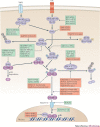Modulation of NF-κB signalling by microbial pathogens
- PMID: 21383764
- PMCID: PMC3611960
- DOI: 10.1038/nrmicro2539
Modulation of NF-κB signalling by microbial pathogens
Abstract
The nuclear factor-κB (NF-κB) family of transcription factors plays a central part in the host response to infection by microbial pathogens, by orchestrating the innate and acquired host immune responses. The NF-κB proteins are activated by diverse signalling pathways that originate from many different cellular receptors and sensors. Many successful pathogens have acquired sophisticated mechanisms to regulate the NF-κB signalling pathways by deploying subversive proteins or hijacking the host signalling molecules. Here, we describe the mechanisms by which viruses and bacteria micromanage the host NF-κB signalling circuitry to favour the continued survival of the pathogen.
Figures



Similar articles
-
Innate Immune Receptors as Competitive Determinants of Cell Fate.Mol Cell. 2017 Jun 15;66(6):750-760. doi: 10.1016/j.molcel.2017.05.009. Mol Cell. 2017. PMID: 28622520 Free PMC article. Review.
-
Manipulation of Non-canonical NF-κB Signaling by Non-oncogenic Viruses.Arch Immunol Ther Exp (Warsz). 2019 Feb;67(1):41-48. doi: 10.1007/s00005-018-0522-x. Epub 2018 Sep 8. Arch Immunol Ther Exp (Warsz). 2019. PMID: 30196473 Free PMC article. Review.
-
Recent advances on viral manipulation of NF-κB signaling pathway.Curr Opin Virol. 2015 Dec;15:103-11. doi: 10.1016/j.coviro.2015.08.013. Epub 2015 Sep 15. Curr Opin Virol. 2015. PMID: 26385424 Free PMC article. Review.
-
Pathogen-mediated posttranslational modifications: A re-emerging field.Cell. 2010 Nov 24;143(5):694-702. doi: 10.1016/j.cell.2010.11.019. Cell. 2010. PMID: 21111231 Free PMC article. Review.
-
Viral interference with innate immunity by preventing NF-κB activity.Cell Microbiol. 2012 Feb;14(2):168-81. doi: 10.1111/j.1462-5822.2011.01720.x. Epub 2011 Nov 23. Cell Microbiol. 2012. PMID: 22050732 Review.
Cited by
-
Mycobacterium tuberculosis suppresses innate immunity by coopting the host ubiquitin system.Nat Immunol. 2015 Mar;16(3):237-45. doi: 10.1038/ni.3096. Epub 2015 Feb 2. Nat Immunol. 2015. PMID: 25642820
-
Citrobacter rodentium NleB Protein Inhibits Tumor Necrosis Factor (TNF) Receptor-associated Factor 3 (TRAF3) Ubiquitination to Reduce Host Type I Interferon Production.J Biol Chem. 2016 Aug 26;291(35):18232-8. doi: 10.1074/jbc.M116.738278. Epub 2016 Jul 7. J Biol Chem. 2016. PMID: 27387501 Free PMC article.
-
Differential signalling requirements for RIPK1-dependent pyroptosis in neutrophils and macrophages.Cell Death Dis. 2024 Jul 4;15(7):479. doi: 10.1038/s41419-024-06871-8. Cell Death Dis. 2024. PMID: 38965211 Free PMC article.
-
The Photomodulation Activity of Metformin Against Oral Microbiome.J Lasers Med Sci. 2019 Summer;10(3):241-250. doi: 10.15171/jlms.2019.39. Epub 2019 Jul 6. J Lasers Med Sci. 2019. PMID: 31749953 Free PMC article. Review.
-
Distinct Cell Transcriptomic Landscapes Upon Henipavirus Infections.Front Microbiol. 2020 May 19;11:986. doi: 10.3389/fmicb.2020.00986. eCollection 2020. Front Microbiol. 2020. PMID: 32508793 Free PMC article.
References
Publication types
MeSH terms
Substances
Grants and funding
LinkOut - more resources
Full Text Sources
Other Literature Sources
Medical

